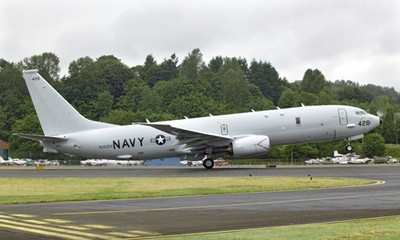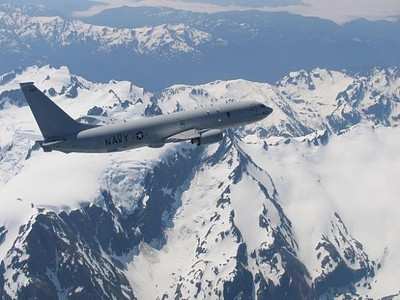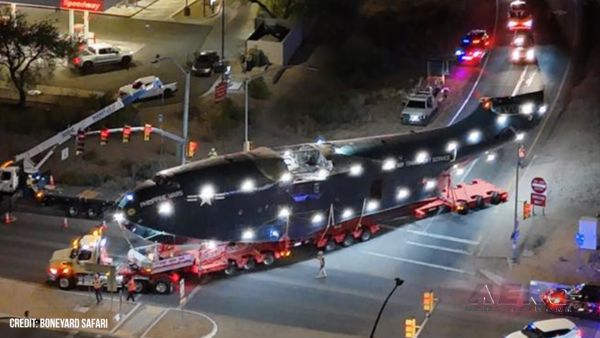Wed, Jul 20, 2011
Navy Plans To Eventually Acquire 117 Of The Aircraft
The first P-8A Poseidon production aircraft completed its first
flight on July 7, taking off from Renton Field and landing three
hours later at Boeing Field in Seattle. The P-8A is the first of
six low-rate initial production (LRIP) aircraft Boeing is building
for the U.S. Navy as part of a $1.6 billion contract awarded in
January.

Boeing Photo
The successful flight marked LRIP-1's
completion of final assembly in the company's Renton factory and
transition to mission system installation and checkout in Seattle.
Boeing will deliver LRIP-1 to the Navy next year in preparation for
initial operational capability, which is planned for 2013.
"This is the first P-8 that will go directly to the fleet in
Jacksonville, FL, so the aircraft's first flight is an important
milestone for the Boeing team and our Navy customer," said Chuck
Dabundo, Boeing vice president and P-8 program manager. "We're on
plan to get LRIP-1 to the Navy in 2012."
"As the Navy's replacement for the P-3 Orion, the P-8A Poseidon
represents the next generation of maritime patrol and
reconnaissance aircraft," said Capt. Michael Moran, program manager
for Naval Air Systems Command's Maritime Patrol and Reconnaissance
Aircraft program office. "The fleet is actively preparing to
receive the LRIP-1 aircraft and begin the transition."

The Navy plans to purchase 117 of the
Boeing Next-Generation 737-based P-8A anti-submarine warfare,
anti-surface warfare, intelligence, surveillance and reconnaissance
aircraft to replace its P-3 fleet. In order to efficiently design
and build the P-8A aircraft, the Boeing-led team is using a
first-in-industry, in-line production process that draws on the
company's Next-Generation 737 production system. All aircraft
modifications unique to the P-8A are made in sequence during
fabrication and assembly.
This is the first P-8A to include a new CFM56-7BE engine
configuration that is now standard on all delivered Next-Generation
737s. The configuration is an improved design that includes high-
and low-pressure turbine modifications. Coupled with drag reduction
improvements that Boeing started phasing into 737 production
earlier this year, it will result in lower fuel consumption and
maintenance cost savings.
Separate from the production contract, Boeing was awarded a System
Development and Demonstration contract in 2004 to build and test
six flight-test and two ground-test P-8A aircraft. The first four
flight-test planes are completing testing at Naval Air Station
Patuxent River, Md. The program's static test plane, S1, completed
its test program earlier this year.
More News
Aero Linx: International Federation of Air Traffic Controllers' Associations (IFATCA) IFATCA is the recognised international organisation representing air traffic controller associ>[...]
“The BlackBird is more than a demonstrator—it’s a flying testbed for the future of aviation. To see it take flight in such a short time is a testament to our team>[...]
Glideslope Intercept Altitude The published minimum altitude to intercept the glideslope in the intermediate segment of an instrument approach. Government charts use the lightning >[...]
Also: MQ-9B UAS MTC, FlightSimExpo, New JPL Director, Japanese Lunar Lander Preps Merlin’s flight testing campaign continues to rapidly progress with its certification-ready >[...]
From 2017 (YouTube Edition): The Airplane From Down Under Is A Proven Trainer… Jabiru was one of the early light sport aircraft (LSA) brought into the U.S.A. when the sport >[...]
 ANN's Daily Aero-Linx (05.16.25)
ANN's Daily Aero-Linx (05.16.25) Aero-News: Quote of the Day (05.16.25)
Aero-News: Quote of the Day (05.16.25) ANN's Daily Aero-Term (05.16.25): Glideslope Intercept Altitude
ANN's Daily Aero-Term (05.16.25): Glideslope Intercept Altitude Airborne-NextGen 05.13.25: Merlin Tests, Dronetag Accuses, Flying Car?
Airborne-NextGen 05.13.25: Merlin Tests, Dronetag Accuses, Flying Car? Classic Aero-TV: Jabiru's New J170-D - An Upgraded and Fine-tuned LSA
Classic Aero-TV: Jabiru's New J170-D - An Upgraded and Fine-tuned LSA




